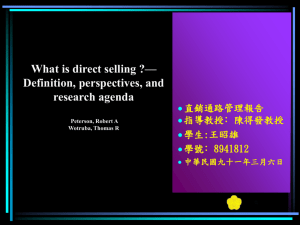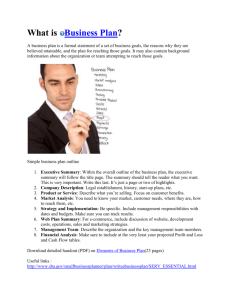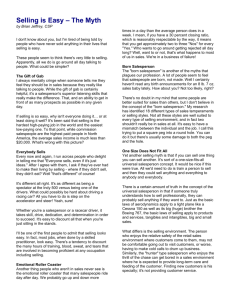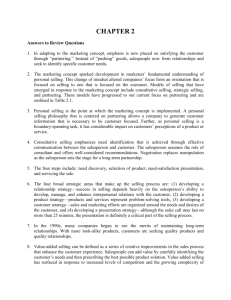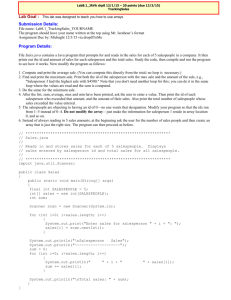understanding and developing the sales force
advertisement
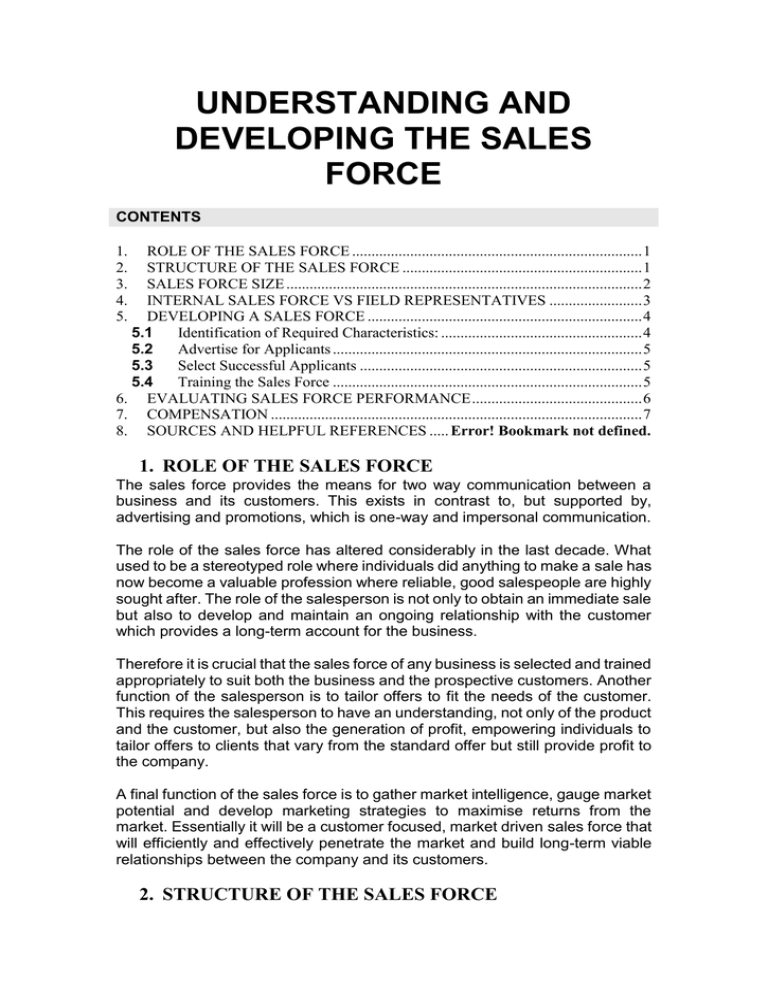
UNDERSTANDING AND DEVELOPING THE SALES FORCE CONTENTS 1. 2. 3. 4. 5. ROLE OF THE SALES FORCE ........................................................................... 1 STRUCTURE OF THE SALES FORCE .............................................................. 1 SALES FORCE SIZE ............................................................................................ 2 INTERNAL SALES FORCE VS FIELD REPRESENTATIVES ........................ 3 DEVELOPING A SALES FORCE ....................................................................... 4 5.1 Identification of Required Characteristics: .................................................... 4 5.2 Advertise for Applicants ................................................................................ 5 5.3 Select Successful Applicants ......................................................................... 5 5.4 Training the Sales Force ................................................................................ 5 6. EVALUATING SALES FORCE PERFORMANCE ............................................ 6 7. COMPENSATION ................................................................................................ 7 8. SOURCES AND HELPFUL REFERENCES ..... Error! Bookmark not defined. 1. ROLE OF THE SALES FORCE The sales force provides the means for two way communication between a business and its customers. This exists in contrast to, but supported by, advertising and promotions, which is one-way and impersonal communication. The role of the sales force has altered considerably in the last decade. What used to be a stereotyped role where individuals did anything to make a sale has now become a valuable profession where reliable, good salespeople are highly sought after. The role of the salesperson is not only to obtain an immediate sale but also to develop and maintain an ongoing relationship with the customer which provides a long-term account for the business. Therefore it is crucial that the sales force of any business is selected and trained appropriately to suit both the business and the prospective customers. Another function of the salesperson is to tailor offers to fit the needs of the customer. This requires the salesperson to have an understanding, not only of the product and the customer, but also the generation of profit, empowering individuals to tailor offers to clients that vary from the standard offer but still provide profit to the company. A final function of the sales force is to gather market intelligence, gauge market potential and develop marketing strategies to maximise returns from the market. Essentially it will be a customer focused, market driven sales force that will efficiently and effectively penetrate the market and build long-term viable relationships between the company and its customers. 2. STRUCTURE OF THE SALES FORCE Sales people exist to communicate between customers and a business. From this communication a relationship often builds between a particular sales person and the customer, in order to preserve this relationship for long term benefits it is important that the customers are divided in such a way that the same sales person provides for the same existing clients, while continually searching for new ones. Presenting an existing client with a new sales person at every contact will do little to build a relationship or develop loyalty toward the business. The division of customers to sales people can be achieved through any of the following methods: Territorial division: Each salesperson is allocated a specific geographical territory usually to market the entire product line of the business. Product division: In some organisations the product lines are so large or the products so complex that it would be unrealistic to expect a single salesperson to know enough detail on all products to satisfy customer queries and close a sale with high success rates. Therefore some sales forces are structured in such a way that individuals specialise in products or product lines. The advantage of this method is the high level of information available to the customer from the salesperson. On the other hand, this method can be costly in travel expenses and may cause reduced efficiency as a number of salespeople from the same organisation may be waiting to present different products to the same customer. Customer/Industry division: This method of structuring categorises customers according to the industry they work in (especially if the product can be sold to a wide variety of industries for various functions), or the size of the account the customer holds with the business. In the former case, it is common for the salespeople to have had experience working in the industry which they now sell to. In the latter case, the more experienced salespeople manage the larger accounts with the least experienced managing minor one-off customers. Another option is to have salespeople who are solely devoted to finding and developing new accounts. As with product division a disadvantage of this approach is additional travel costs, the positive is the focus on the customer, meeting their needs and maintaining frequent and loyal customers. Complex division: This classification is when any or all of the above methods are combined. 3. SALES FORCE SIZE Unfortunately there is no strict method for determining the required size of a sales force. It is recommended that businesses look to industry norms and averages to help here. Another option is to determine the number of sales calls that the business generally needs to make in a specified time to produce enough closed deals to provide sufficient profit. You will need to determine how many sales calls one salesperson can make in the same period of time and then divide the total number by the individuals’ amount. The answer will be the approximate number of salespeople required to meet the target. However, this method works on the assumption that all the salespeople will work at the same pace as the test individual. Additional considerations to take into account when considering sales force size include: The method used for making sales calls e.g. face to face or telemarketing; The age of the product e.g. new products may need a greater sales push than older products in order to improve customer awareness and understanding; and The usefulness of the sales force e.g. a sales division may not be the best method of reaching the customer. Occasionally mailorder catalogues will provide an equal or better result then the sales force. It is important to first answer the following questions: What function is the sales force supposed or expected to serve? Is this the best means of carrying out this function? When these questions have been answered, then size the sales force accordingly and remember the size of the sales force required may fluctuate greatly as the business launches new products or enters into new endeavours. A means of overcoming this is to always consider having part time salespeople which can provide a buffer in times of need and can be reduced at other times. 4. INTERNAL SALES REPRESENTATIVES FORCE VS FIELD Using field representatives as the sales force can lead to high costs and a large amount of wasted time in travel. An alternative is to have an internal sales force, i.e. a sales force that never leaves the office, such as telemarketers, technical support or sales assistants. Internal Sales Force: Advantages Reduced time wasted on travel Reduced expenses Disadvantages Less personal contact with buyer Harder to build a personal relationship with the buyer Increased number of contacts made Harder to capture the buyers per day immediate interest Field Representatives: Advantages Easier to build a personal relationship with the buyer Possible to grab the attention of the buyer easier with face to face contact rather then over the phone Easier to obtain customers through referrals to their colleagues where the buyer actually knows and has met the sales person Disadvantages More time lost in travel More and higher expenses Fewer contacts made per day The type of sales force used will depend on the industry within which the business operates. The following should be considered when determining the most appropriate method of sales representation: What size sales force can the company afford? How far geographically spread are the customers? Is the product or service on offer too complex to be sold without a physical demonstration? What is the preference of the industry i.e. in some industries managers may not want to see salespeople and would prefer to see mail-outs and then call the company to place an order or seek further information? A possible option is to use a combination of the above approaches and either: Use telemarketers to locate possible new customers for field representatives to visit and develop a relationship with. This would essentially reduce travel time and expenses wasted by field representatives attempting to locate new customers; or Use field representatives to make the initial contact and then provide support for the new customer through internal technical support lines. 5. DEVELOPING A SALES FORCE The sales force is the face of the business which is visible to the customer. Therefore it is important that the selection, recruitment and training processes are undertaken with great care. The steps in developing a sales force include: 5.1 Identification of Required Characteristics: Contrary to popular belief not all sales positions are the same. Therefore it is difficult to identify the characteristics an applicant is required to have to become a successful salesperson. Some methods of identifying the characteristics that may be required include: Look at your most successful salespeople, what are the characteristics they have that make them successful? Look at the job duties the person is required to carry out e.g. is there a lot of travel involved? Is there a lot of paperwork to be done? Look at the sales force of competitors, what makes them successful? Some common characteristics of successful salespeople include: Tact, good judgment, well developed people and communication skills, honesty, trustworthyness and an ability to see things from a customer viewpoint. Another important attribute of a successful salesperson is the ability to understand the business implications of a sale that they make i.e. depending on the product, the success of the salesperson should be measured, not only on the volume of closed deals, but also on the financial impact those deals have on the company. 5.2 Advertise for Applicants There are many methods that may be employed to attract applicants, these include: Newspapers; Recruitment agencies; Asking current employees to put names forward; Existing networks; Online job advertisements; and Universities. The hardest part of this task is communicating to applicants that sales is a profession, not just a job. This may be overcome through expressing opportunities for career advancement, professional development and other benefits. 5.3 Select Successful Applicants The selection process can involve many activities including: Interviews; Testing e.g. to review ability to recall product knowledge, analytical or organisational skills; Practical exercises e.g. to determine natural selling abilities; Review of the characteristics identified in step one; Conference with references; and Review of past employment. Ultimately it will be the interviewer’s reactions which determine the success of an applicant. While this is important an interviewer should also consider how the applicant rates on a predetermined set of required results. For example: Is the applicant expected to stay with the company and be available for promotion? – determine if this is what the applicant expects to obtain from the position; Determine a required level of natural selling ability required by a successful applicant; Determine required minimum test results required by applicants; and Determine whether the applicant fits in with the culture of your business. Criteria such as this will help the selection process remain objective and reduce clouding by personal opinions of the interviewers. 5.4 Training the Sales Force Training is a crucial aspect to developing a successful sales force. As it is the sales force that the customer sees as the face of the business it is important that they make a good impression on the customer at all times. For this reason it is expected that businesses invest what can sometimes be significant amounts of capital into training programs. A training program may vary from weeks to months in length depending on the job duties and industry of the business. Ideally a salesperson should exit a training program with a full working knowledge of the business. History – Length of time in operation, major success or failures, etc; Purpose – Vision, mission and value statements; Products – How they are made, how they should be operated, their purpose, etc; Distributors – Who sells the products? Competitors – Who else is in the same line of business and what differentiates your product from theirs? Current clients – What motivates them to buy your products, who are they and what selling techniques have worked best to maintain these relationships? Much emphasis will also be placed developing communication, personal and selling skills as well as the production, purpose and use of specific reports and recording of expenses. Finally, training should always be an ongoing process. The sales force should sell for certain periods of time and then be recalled for further training or updating of knowledge. 6. EVALUATING SALES FORCE PERFORMANCE Once the sales force is in contact with the market it is important to evaluate their performance or effectiveness to ensure they are achieving goals and communicating the right message to the marketplace. To do this requires feedback from the market and the salespeople themselves. Some methods of evaluating the sales force’s effectiveness includes: Submitting workplans. These tell a manager how good an employee is at planning their work and following that plan. The workplan should contain information regarding which contacts will be made and/or followed up and how successful each contact was; Developing long and short term goals and following up on progress towards those set goals. e.g. Sales quotas or targets which state how much should be sold in a set period of time; Call reports which outline the status of every client account and the action taken to maintain those accounts. Managers can determine from these reports if employees are making enough calls per day, if enough deals are being closed by the employee, are they focusing too much on new customers and not maintaining existing ones, etc; and Formal evaluation may be used where a manager sits down and discusses performance with the employee. Refer to the Employee Evaluation guide for assistance with this method of evaluation. Evaluation should also be an ongoing process to ensure the sales force is focused on working toward common goals together. However, it should be noted that implementing too many reports as a means of evaluation will also increase the workload of the employee which will quite often result in reduced time available to concentrate on their core responsibility - making sales. A final technique for evaluating sales performance is comparing past with current sales levels. However, if this technique is used it is important to look at the product mix which is actually being sold by the individual. A manager may find that although high numbers of deals are being closed, these deals maybe the result of the salesperson pushing a simple product to sell and not focusing on other more important profit making products, thus not contributing significantly to gross profit overall. It is a beneficial technique, however, if the manager continually looks at the product mix and determines quotas for each product which must be met. 7. COMPENSATION The sales force can be a very important asset to a business. Often substantial amounts of money are invested in the selection, recruitment, training and evaluating of salespeople. Therefore it is important to show the sales force how valued they are in an attempt to minimise turnover. The methods of compensation vary significantly between industries, some include: A fixed salary at a competitive rate – provides a stable income for the salesperson; Commission – provides an incentive for the salesperson to generate a sufficient level of sales activity to meet the company’s objectives; Bonus – provides an incentive for the salesperson to extract greater value from the sales activity that they generate; Benefits such as an expense account, insurance, childcare, etc. – provide an employee with job satisfaction and a greater willingness to work for a business that treats them well; Incentives such as cash awards, holidays and conferences - offered occasionally generate a greater selling effort and reward the effort; and Training and opportunities for Professional Development - are well regarded by many professional salespeople as an intangible but valuable benefit of working with a progressive employer. Any of the above methods may exist in combination to offer stability to an employee as well as incentives and rewards for effort. It is possible to alter the bonuses and incentives on an annual basis to align with new or changing business goals. However, in order to obtain maximum benefit from such schemes as commission, bonuses or incentives, the employees must see that the goals or quotas required to receive this compensation are achievable. To do otherwise would create a sense of little value and job satisfaction within the sales force which could ultimately result in high employee turnover and more expenses outlaid in developing new salespeople.



